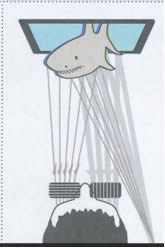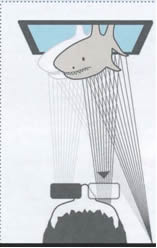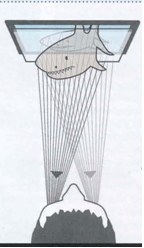Stereoscopic Projection
Methods currently in use:
|
|
|
|
|
|
As with all 3D formats, this system displays two slightly different views of the same scene, one offset from the other horizontally, simulating the two views of our own eyes. With anaglyphs, both images are displayed at once, with one image tinted in red and the other in cyan. Glasses with matching red and cyan filters ensure that only one of the images reaches each eye. These are then combined by the brain to create the illusion of 3D. |
Here the two images are displayed simultaneously and projected through filters that polarise each in its own direction. Corresponding polarising glasses are required to view the effect The polarized lenses only pick up the image that's meant for them. |
Separate images for the left and right eye are recorded at full 1080p quality and played back alternately at high speed. Then, special battery-powered glasses with actively driven LCD shutters are used: these rapidly block the right and left views alternately, in sync with the video, so that each eye receives the correct image in the correct sequence. |
Also known as auto-stereoscopic, this glasses-free system is regarded by many as the ideal long-term 3D solution, and is currently in use on FujlfiIm's Real 3D W1. |
|
STRENGTHS |
|||
|
It can be used with existing TV |
It s the 3D system of choice in cinema, so the technology required to make it work is widespread. It is SKY Channel's chosen broadcasting system and the polarising specs are reasonably painless to wear. |
It really works. You get the full |
No glasses are required, so there is no loss in brightness and no colour degradation. |
|
WEAKNESSES |
|||
|
The red/cyan filter system strips |
You need a polarising 3D TV (or |
Requires a display with a super-high refresh rate (genuine 120Hz or better) and a video source to |
It is phenomenally complex to |
|
USED BY |
|||
|
Early 3D DVDs, Blu-rays and |
Hollywood films, SKY Channel, SONY, Hyundai |
Nvidia, Panasonic, Sony, Samsung |
FUJI film, PIONEER and Philips though Philips has been cautious in launching consumer products |
|
CHANCES OF SUCCESS |
|||
|
Negligible. Its day is done, except |
In the cinema? Huge. In the living-room? That all depends on TV-stations and the willingness to buy a new TV |
Considerable. Seemingly everyone in consumer electronics wants us to have it in the home. |
Long-term, this might be what |
Recently, it seems that auto-stereoscopic screens increase in market popularity. In a simple 3D screen, a very fine grating, called a "parallax barrier", is placed in front of the LCD screen. It does the job of the polarising glasses, directing light from each image slightly differently so that at a so-called "sweet spot" about 20 inches in front of the screen the two images are separated just enough that the brain will create a composite 3D image. The downside of this is that since the parallax barrier is a permanent feature of the monitor, then it's always in 3D mode unless a 'switching' mechanism is introduced.
In such a screen introduced commercially by SHARP in 2003 and also used by FUJI in their 3D camera and picture frame marketed at the end of 2009, the parallax barrier is created by a second LCD screen - known as the "switching" LCD - which is off in normal 2D mode. When this screen is activated, it polarises in stripes so that it is impenetrable to light from the first LCD screen, generating opaque grid lines in front of the normal screen. The following graphic is from Sharp's background to the process:

The limiting factor on this method is that you have to have your head in exactly the right spot to see the 3D image, so no peering over shoulders allowed, however, this can also be an advantage in cases where two distinct 2D images are simultaneously projected to two opposing directions, such as in RANGE-ROVER mdl 2009 GPS screen. Multiple viewer screens are not much more complicated to make: the parallax barrier is finer and cross hatched instead of striped. However, making the images for such a screen is much harder, since instead of two pictures, the 3D image is created by combining at least four viewpoints.



 ANAGLYPH
ANAGLYPH POLARISING
POLARISING  ACTIVE SHUTTER
ACTIVE SHUTTER  LENTICULAR
LENTICULAR